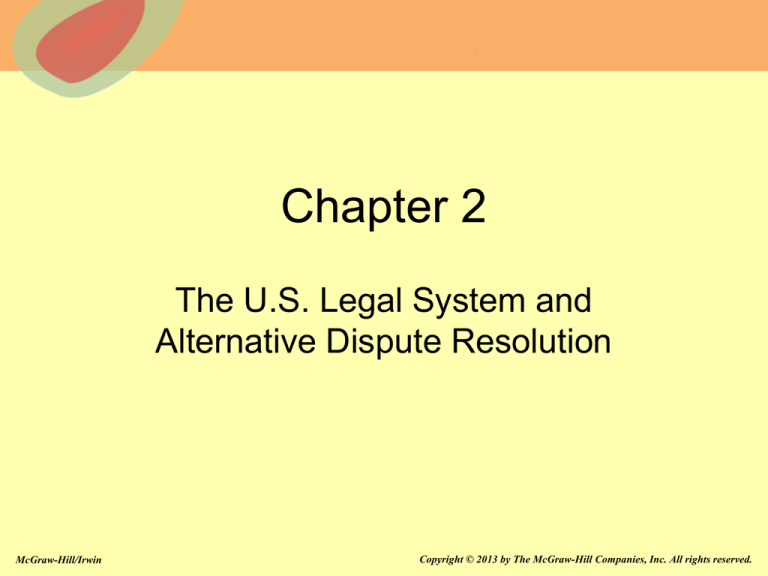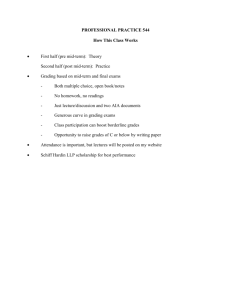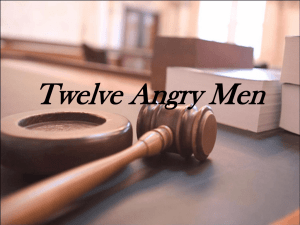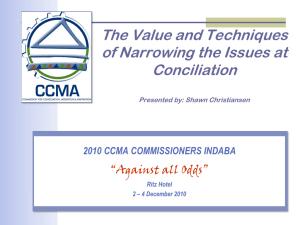
Chapter 2
The U.S. Legal System and
Alternative Dispute Resolution
McGraw-Hill/Irwin
Copyright © 2013 by The McGraw-Hill Companies, Inc. All rights reserved.
Chapter 2 Case Hypothetical
Officer Brian Perkins was having a difficult Monday morning. For the past three hours, he was responsible for “serving
process” in three (3) civil cases (As Chapter 3 indicates, service of process is the procedure by which courts present
litigation documents to defendants. Those documents typically consist of a complaint, which specifies the factual and
legal basis for the lawsuit and the relief the plaintiff seeks, and a summons, a court order that notifies the defendant of
the lawsuit and explains how and when to respond to the complaint). For the first civil case, Merriwether v. Alstott,
Officer Perkins attempted to serve the defendant Harry Alstott at his home, but no one appeared to be there. For the
second civil case, Setliff v. Sanders, the person answering the door claimed the defendant, Marshall Sanders, did not
live there, and that he did not even know who Marshall Sanders was. Leaving the premises, Officer Perkins surmised
that the residential address indicated on the summons was incorrect. Either that, or the person who answered the door
was lying.
For his third attempt at service of process that morning, in a lawsuit captioned Jackson v. Graves, Officer Perkins drove
to the home of Laticia M. Graves at 721 Magnolia Street. Officer Perkins knocked on the door of the dilapidated house,
and although no one answered the door, a second-story window opened almost immediately. A female in the house
looked down from her second story vantage point and pointedly asked Officer Perkins, “What do you want?” Officer
Perkins responded with a question, “Are you Laticia Graves,” to which the woman responded, “Yeah. What’s it to you?”
Officer Perkins asked the not-so-polite occupant to open the door, to which she responded, “I ain’t comin’ down there,
and if you ain’t got a warrant, you ain’t comin’ in.” Frustrated, Officer Perkins replied, “Well, I have civil papers to serve
you, ma’am, and if you won’t come down to get them, I’m going to put them in your mailbox.” The response was, “I ain’t
comin’ to the door.”
Officer Perkins immediately proceeded to the mailbox, and put the complaint and summons in the matter of Jackson v.
Graves in the box. The address on the mailbox indicated 721 Magnolia Street. In his notes, Officer Graves wrote that
the defendant, Laticia Graves, had been served with process on Monday, September 13, 2010 at 11:47 a.m. As he
entered his patrol car, Officer Perkins looked backed at the second-story window from which he had received his
impolite greeting. The woman had since closed the window, and was watching his every move.
Did Officer Perkins effectively serve process on the defendant, Laticia Graves? Why or why not?
2-2
Chapter 2 Case Hypothetical
Defendant Woodson is an African-American male accused of murdering a white female in
an apartment burglary. During the jury selection process, Prosecutor Forbes exercises
only two peremptory challenges, excusing from service the only two African-Americans
sitting in the jury. An all-white jury is eventually empanelled, and Defendant Woodson is
convicted of first-degree murder, with life imprisonment imposed as punishment.
After the jury verdict is announced, Prosecutor Forbes is questioned by the local media
concerning his exercise of the peremptory challenges. Prosecutor Forbes explains that
race was not a factor in his decision, but that the two potential jurors were excused
“because they have facial hair, and as a matter of practice, I do not want individuals with
facial hair serving on my jury.” Further, Prosecutor Forbes states “I categorically deny
that race played any factor whatsoever in the jury selection process.”
On appeal, should the appellate court: 1) deem Prosecutor Forbes’ actions reversible
error, and remand the case to the trial court level to be retried; 2) vacate (nullify) the jury
verdict, and dismiss the charges against Defendant Woodson; or 3) allow the conviction
to stand? Should prosecutors be allowed to consider race as a factor in the jury selection
process? Gender? Age?
2-3
Chapter 2 Case Hypothetical and Ethical Dilemma
Ted Henry, trial court administrator of the Ticonderoga County, New York court system, has grown tired of all of the
relatively trivial cases plaguing his county’s court dockets. In Ted’s opinion, everyone wants to exercise their “uniquely
American” right to sue these days, even when the amount in controversy is comparatively trivial; in Ticonderoga
County, for example, the number of cases valued at less than $10,000 has doubled in the past ten (10) years. Ted
blames the increase in “low-value” litigation on our litigious culture. He firmly believes that after having watched an
overabundance of legal melodramas on television, every American either wants to be a lawyer, or get a lawyer.
As a trial court administrator, Ted has been especially affected by the increase in litigation. Ticonderoga County’s
financial resources are limited, especially during difficult economic times. For Ted, it has become increasingly
challenging for him to manage the trial court docket each week with only a limited number of judges, bailiffs, trial
transcriptionists, and other key court personnel available. Ted knows that when it comes to the courtroom, time is
definitely money, and local taxpayers have not exactly “warmed up” to the idea of hiring more judges and other court
personnel to respond to the onslaught of increased litigation.
Ted has what he believes to be a “modest proposal.” In Ticonderoga County, he would like to implement binding
arbitration for each case involving an amount in controversy of less than $10,000 (In binding arbitration, the arbitrator’s
decision is final and non-appealable). As part of his proposal, the parties involved in the litigation (plaintiff and
defendant) would pay for the expenses of arbitration, and select the arbitrator. In law school, Ted’s first-year torts
professor had told his class that there was no guarantee of justice in the courtroom, and based on his experience, Ted
believed that his professor had been correct in that assessment; after all, there were too many contingencies and
variables in the courtroom to guarantee justice, including the effectiveness of legal counsel, the proclivities of the judge
presiding over the case, and the makeup of the jury. In Ted’s view, who is to say that justice would not be better served
in a case if a neutral, experienced arbitrator was involved in the dispute resolution, as opposed to a judge and jury in a
traditional courtroom? Ted is excited about his proposal, since (if implemented) it would reduce dramatically the number
of cases processed through the regular Ticonderoga County judicial system, thereby saving the taxpayers money, and
Ted’s sanity!
Is Ted Henry’s proposal, for binding arbitration in all civil cases involving less than $10,000 in controversy, legal? Is it
ethical?
2-4
Chapter 2 Case Hypothetical
John Wilson, owner of Wilson Construction Company, and Andrew Carrigan, owner
of Carrigan Brick and Masonry, Inc., are at odds regarding a construction contract
between the two companies. Wilson claims that Carrigan breached the contract
due to non-performance of certain masonry work; Carrigan defends on the basis
that Wilson did not permit him adequate access to the work site in order to complete
the work by the designated contract deadline. Wilson claims liquidated damages as
a result of the breach; the contract stipulates that upon breach, the non-breaching
party is entitled to $1,000 in damages for every day the work is not performed
beyond the contract deadline.
Wilson is considering mediation or arbitration as an alternative to civil litigation, but
he is concerned that “justice may not be served” if he submits to a method of
alternative dispute resolution. Are his concerns justified? Is justice better
guaranteed if Wilson and Carrigan litigate their case? Is mediation or arbitration
actually preferable to civil litigation? Regardless of what disputing parties prefer,
should court systems require that plaintiffs and defendants submit to arbitration or
meditation before being entitled to their “day in court?”
2-5
Types of Jurisdiction
• Original Jurisdiction:
The power to hear
and decide cases
when they first enter
the legal system
• Appellate Jurisdiction:
The power to review
previous judicial
decisions to
determine whether
trial courts erred in
their decisions
2-6
Types of Jurisdiction
• In personam
jurisdiction: The
power to render a
decision affecting the
rights of the specific
persons before the
court
• Subject-matter
jurisdiction: The
power to hear certain
kinds of cases
2-7
Subject-Matter Jurisdiction:
Exclusive Federal Jurisdiction
•
•
•
•
Admiralty cases
Bankruptcy cases
Federal criminal prosecutions
Cases in which one state sues another
state
• Claims against the United States
• Federal patent, trademark, and copyright
claims
• Other claims involving federal statutes that
specify exclusive federal jurisdiction
2-8
Subject-Matter Jurisdiction:
State Jurisdiction
• All cases not falling under
Exclusive Federal Jurisdiction
2-9
Subject-Matter Jurisdiction:
Concurrent Federal and State
Jurisdiction
• Federal question cases
• Diversity of citizenship cases
2-10
The Federal Court System
• The United States Supreme
Court
• Intermediate Courts of Appeal
• Federal Trial Courts (U.S.
District Courts)
2-11
State Court Systems
• State Supreme Courts
• Intermediate Courts of Appeal
• State Trial Courts
2-12
Threshold Requirements for Litigation
• Standing (to sue)
-Actual/imminent injury in fact
-Injury traceable to actions of defendant
-Injury redressed by favorable decision
• Case or Controversy (Justifiable Controversy)
-Adverse relationship between plaintiff and
defendant
-Actions of one party give rise to legal dispute
-Court decision able to resolve dispute
• Ripeness
-Decision able to affect parties immediately
2-13
Steps in Civil Litigation:
The Pretrial Stage
•
•
•
•
•
•
•
Informal Negotiations
Pleadings
Service of Process
Defendant’s Response
Pretrial Motions
Discovery
Pretrial Conference
2-14
Steps in Civil Litigation:
The Trial
• Jury Selection
• Opening Statements
• Examination of Witnesses and
Presentation of Evidence
• Closing Arguments
• Jury Instructions
2-15
Steps in Civil Litigation:
Post-Trial Motions
• Motion For Judgment In
Accordance With Verdict
• Motion For Judgment
Notwithstanding Verdict
• Motion For New Trial
2-16
Steps in Civil Litigation:
Appellate Procedure
2-17
Appellate Court Decision-Making
Powers
•
•
•
•
Affirmation
Modification
Reversal
Remand
2-18
Alternative Dispute Resolution
2-19
Alternative Dispute Resolution
Definition: The resolution of legal
disputes through methods other than
litigation, such as negotiation,
mediation, arbitration, summary jury
trials, mini-trials, neutral case
evaluations, and private trials
2-20
Reasons A Business Might Prefer
Alternative Dispute Resolution (ADR)
Versus Litigation
• ADR methods are generally faster and
less expensive than litigation
• Business may wish to avoid uncertainty
associated with a jury decision
• Business may wish to avoid setting
precedent through court decision
• Business may prefer confidential nature
of ADR
2-21
Primary Forms of Alternative
Dispute Resolution
• Negotiation
• Mediation
• Arbitration
2-22
Advantages of Mediation
• Helps disputing parties preserve
their professional relationships
• Provides possibility of finding
creative solutions to dispute
• Offers participants high level of
autonomy
2-23
Disadvantages of Mediation
• Appears to be an equal process and
solution, thereby hiding power
imbalances that would lead to the
party with greater power securing an
agreement of greater benefit
• Some enter mediation with no
intention of finding a solution, and
use mediation as a delay tactic
2-24
Advantages of Arbitration
• More efficient and less expensive than
litigation
• Parties have more control over the process
of dispute resolution (parties choose the
arbitrator and determine how formal the
process will be)
• Parties can choose arbitrator with expertise
in specific subject matter of dispute
• Arbitrator has greater flexibility in decisionmaking (compared to decision-making
authority of judge)
2-25
Disadvantages of Arbitration
• As use of arbitration increases,
efficiencies and lower cost advantages
(compared to litigation) decrease
• Difficulty of appealing an arbitration
award
• Loss of civil rights and remedies
available through litigation
• Companies and employers may
effectively “hide” their disputes through
arbitration (non-public nature of
arbitration versus public trial)
2-26
Binding Arbitration Clause
Definition: A provision in a contract
mandating that all disputes arising
under a contract must be settled by
arbitration
2-27
Other Alternative Dispute
Resolution Methods
•
•
•
•
•
Mediation-Arbitration (“Med-Arb”)
Summary Jury Trial
Mini-Trial
Early Neutral Case Evaluation
Private Trials
2-28





